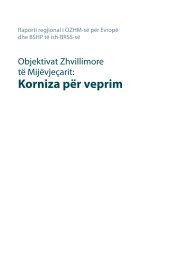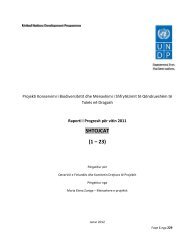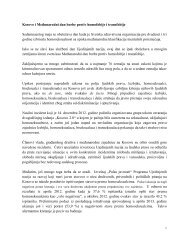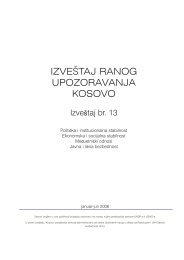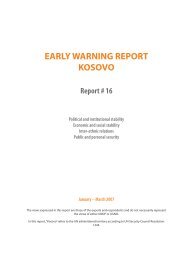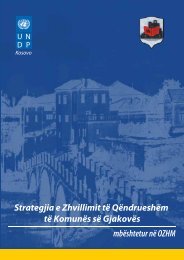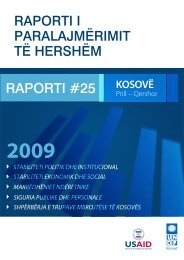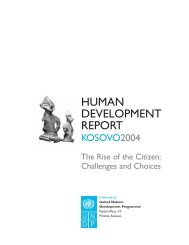Kosovo Human Development Report 2010 - UNDP Kosovo - United ...
Kosovo Human Development Report 2010 - UNDP Kosovo - United ...
Kosovo Human Development Report 2010 - UNDP Kosovo - United ...
Create successful ePaper yourself
Turn your PDF publications into a flip-book with our unique Google optimized e-Paper software.
sive education depends on deep<br />
cooperation between families, societies<br />
and governments to ensure<br />
that this fundamental right is<br />
met. In <strong>Kosovo</strong>, social cohesion is<br />
weak and fractured. Societies reject<br />
the full participation of minority<br />
groups (particularly RAE communities),<br />
hide disabled children and<br />
have little trust in their governance<br />
structures. The concept of education<br />
as a driver of life opportunity<br />
is also threatened by a climate of<br />
patronage, corruption and widespread<br />
unemployment. True mobilization<br />
of public, private, voluntary,<br />
economic and human resources<br />
towards education for all is therefore<br />
still an unrealized dream.<br />
(ii) Governance drivers<br />
• Weak accountability of policy<br />
implementation: the MEST (Ministry<br />
of Education, Science and<br />
Technology) has made an effort to<br />
enshrine principles of inclusion in<br />
its sectoral policies. 86 For example,<br />
municipalities with minority communities<br />
are entitled to additional<br />
rights in education - such as the organization<br />
of higher education institutions<br />
(e.g., University in North<br />
Mitrovica). However, education<br />
laws, regulations and strategies<br />
often remain statements of good<br />
intentions without any follow-up<br />
implementation or proper reporting.<br />
These shortfalls are partially<br />
attributable to unrealistic planning,<br />
and also to limited sector-level implementation<br />
capacities. Mechanisms<br />
for policy implementation<br />
and adequate budget planning are<br />
lacking. This reflects a fundamental<br />
contradiction between official<br />
political commitment to an integrated<br />
and non-discriminatory educational<br />
system and the reality on<br />
the ground. As a consequence, instead<br />
of addressing the fundamen-<br />
tal barriers to implementing new<br />
educational legislation, policymakers<br />
rather redraft or amend laws<br />
repeatedly. 87 In addition, the lack<br />
of census data makes it impossible<br />
to accurately calculate the percentage<br />
of children enrolled into<br />
the education establishments in<br />
<strong>Kosovo</strong>. The numbers range from<br />
95-104 percent. Data on ethnic minorities<br />
and children with special<br />
needs are almost non-existent and<br />
unreliable.<br />
• Limited budget allocation for<br />
education and in particular for<br />
measures targeting social inclusion:<br />
access to quality education<br />
depends mostly on the availability of<br />
finance, infrastructure, policies and<br />
programmes supporting quality inclusive<br />
education. With this in mind,<br />
<strong>Kosovo</strong>’s education sector budget<br />
falls far short of needs. In 2001, <strong>Kosovo</strong><br />
allocated around 3.8 percent of<br />
GDP to education, a figure comparable<br />
with low to medium income<br />
countries. 88 From 2004 to 2006 <strong>Kosovo</strong>’s<br />
budget allocations for education<br />
increased from 3.9 percent to 4.4<br />
percent of GDP. 89 However, in 2009<br />
the budget allocation for education<br />
declined to 3.7 percent of GDP. 90 Although<br />
this is close to the EU average<br />
(4-5 percent of GDP), the actual<br />
amount allocated to the education<br />
system is insufficient considering the<br />
sector’s needs. Insufficient budget<br />
allocations have a negative impact<br />
on the ratios of teachers to students<br />
in <strong>Kosovo</strong>. The teacher-student ratio<br />
in <strong>Kosovo</strong> is 18.2 to one in elementary,<br />
and 20.3 to one in secondary<br />
schools (MEST, 2009), an unbalanced<br />
ratio when compared with other<br />
countries in the Western Balkans.<br />
In Serbia, for example, the teacherstudent<br />
ratio in 2006 was 13.8 to one<br />
in elementary and 10.7 to one in the<br />
secondary education. 91 In developed<br />
countries the teacher-student ratio is<br />
ACCESS TO EDUCATION AND EXCLUSION<br />
| 57



